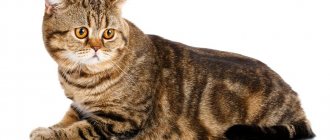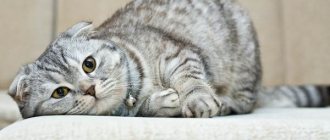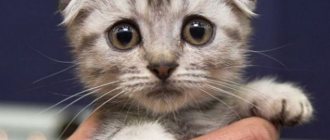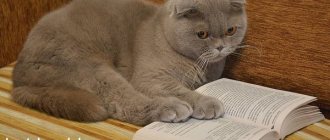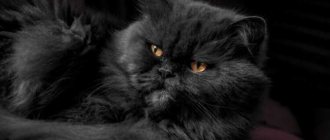With the appearance of a little fluffy Scotsman in the house, a lot of questions arise about the care and nutrition of the baby. In another situation, it is interesting to find out about the character of the cat and the characteristics of its health before deciding to purchase such a miracle.
Who is the Scottish Straight cat, how did he appear and what distinguishes him from the so similar British cat.
And it was like this
On a Scottish farm, almost 60 years ago, a cat named Susie was born. Later, the owner of the farm noticed an amazing feature of the kitten - her ears were bent and smaller than usual. Otherwise, the kitten was no different from its mother.
Over time, the fold-eared cat was noticed by the British scientist William Ross. And he took the girl to him.
When Susie became a mother herself, one of her cubs again turned out to be a kitten with drooping ears. Since then, Ross began breeding the breed. Both regular and fold-eared kittens were born in the litter.
As we studied the breed, it turned out that this feature of the ear structure is due to a defective gene. And this gene brings with it health problems, including disability of the animal.
So the breed was banned in Great Britain, and the Scots went to America. There, scientists crossed the Scottish Fold cat with the British Shorthair. The result was kittens with normal ears and drooping ones.
But the latter no longer had a great genetic predisposition to diseases. After all, 2 thirds of their genes were healthy, which means that only minor health features remained - a tendency to diseases of the joints and cardiovascular system.
What is the difference between straight and british
As a result of this crossing, 2 new cat breeds appeared: Scottish Fold - fold; and Scottish Straight - straight-eared.
Only the Straights have long been classified as British due to their external similarity and genetic relatedness. Until in 2004 the differences between the breeds were recognized and the Scottish Straight breed was officially registered.
Differences between breeds in the following indicators:
- Scots are lighter and slimmer;
- The British have a more “knocked down” skeleton;
- the childish expression of the face remains in the animal’s adulthood, unlike the British. This is due to the different structure of the skull and the position of the nose;
- The muzzle is more rounded in Scottish cats.
Character
By nature, this is not a conflict animal. Ideally gets along with small children or other pets. Due to its dislike of conflicts, the cat would prefer to calmly leave rather than start defending itself and extending its claws.
The cat does not like to be picked up against his will. He will not fulfill your requests without desire.
It is easy to train, so there will be no problems with potty training. Parenting is also easy - the baby quickly understands what not to do.
He won't suffer much from loneliness if you have to leave for work until the evening. At the same time, he is quite loving - he loves affection and stroking from the owner.
But if you are busy, then the cat will not insist on playing and make noise for no reason. He can wait.
- Where can I take veterinary courses and what are they for?
Akita Inu. What kind of breed is this and what are its characteristics?
Siamese cat - description of the breed, character and features of caring for Siamese cats (105 photos and videos)
Scottish fold cat (Scottish fold): reviews - positive and negative
Galina, owner of the Scottish Fold (girls)
It’s so strange, but great human happiness can be bought for very little money. Or even get it for free. Perhaps animals are the only case where this is real. Although from this judgment one might get the opinion that bought a cat = bought love. This is wrong. Love still needs to be earned. And you can earn it only by loving your cat. With the Scots this statement is doubly true, because they are very proud and have a cat's dignity.
Mark, owner of Scottish Fold (girls)
Our cat, when we brought her home, almost immediately raised her tail and began to look around the room. So brave. This breed is very well-mannered, they have good manners in their blood. I got used to the tray from the first days. Now, if the tray is removed, for example, when we wash it, it will scream until the last minute, demanding to return it, but will not shit on the floor.
Marina, owner of a Highland Fold (boy)
If you want a plush that you can cuddle with and hold in your arms all the time, then this cat is not for you. This is an arrogant, proud cat, on his own mind. Doesn't like to sit on hands. He will do something on your order only when it is beneficial for him. And another feature is that when our cat is molting, it is impossible to stay in the house. There are tufts of fur flying everywhere. But this is due to the fact that he is a Scots Longhair. I think there are no such problems with shorthaired Scots. We suffered for the first two years, and then the veterinarian advised us to give the cat vitamins seasonally to strengthen the coat. Now during molts not so much falls out. And the wool looks better.
Peter, owner of Scottish Fold (boy)
There is an opinion that Scottish cats have downright English manners and the same character. I don’t know about others, but my one-year-old Kiryusha is a terrible Skoda. He ignores the scratching post, but tears up the wallpaper and ottoman, rides on the curtains, and eats the flowers. Maybe it's because he's only a year old. Or maybe upbringing. We took him in when he was already grown up - at 5 months. In general, we're having fun for now.
Oksana, owner of Scottish Fold (girls)
What surprised me about my Sonya was that, despite her plush appearance, she didn’t really want to be held. It was so at 2 months, it was so at six months, and it is so now when we are 2 years old. I thought it was just her peculiarity. But it turned out that this breed, in general, is not particularly tame. They would rather sit next to their owner than in his arms. If you can come to terms with this fact, then you will be happy. In all other respects, these cats are very cute creatures who love their owners, follow them all the time - true friends. And their habits are more like dogs.
Katerina, owner of Highland Fold (girls)
They say that Scottish cats are good because they have a calm temperament and they mature late, at about a year. I want to dispel this myth. For example, my 5-month-old girl asked for a cat. And she asked him in a way that the cat who lived with us before her had never asked - a mixture of a Persian and a stern Norwegian. In short, she howled so much that we immediately understood: we need to sterilize her. But to say that such a temperament is something that can turn a cat away is wrong.
Oleg, owner of Scottish Fold (boy)
We became the owners of a fold-eared cat with erect ears. It turns out that if you take a fold-eared cat younger than two months, you can end up in a situation where his ears stand up. Some cats have this peculiarity: the lop ear gene is present, but the ears still stand up. My wife and I really wanted the fold, but we still love our Lord very much, despite his erect ears.
Dina, owner of Scottish Fold (boy)
Article continues after advertisement
I would like to share a problem that is typical for Scots. This is urolithiasis. When we were about 2 years old, we suddenly stopped going to the litter box and started urinating nearby. The first time we scolded our cat, and then we saw blood in his urine and realized that the matter was serious. We took him to the vet and they gave us a disappointing diagnosis. They prescribed a course of treatment and a strict diet. I managed to enter a state of remission in just a few days. Now we keep our finger on the pulse all the time and do not deviate from the diet.
Sasha, owner of Highland Fold (girls)
The Scottish cat is an inexhaustible source of positivity, a direct generator of it. These cats love to purr and chatter, so we can conclude that they are always comfortable. They talk constantly. Sometimes to the point of obsession. But they don’t like to be held in their hands and, despite their positive attitude, they are quite nervous. That is, even to ordinary sounds they sometimes react too timidly. And since the breed is also non-aggressive, I would not let it out into the street - it will definitely be offended by someone.
Nastya, owner of Scottish Fold (girls)
Fold owners should understand one thing: floppy ears are the result of unfortunate genetic mutations that affect not only the ears, but also the musculoskeletal system. Our Marquise has dysplasia. She's limping. And she feels uncomfortable jumping. The vet said that she is not in pain yet, but there is already discomfort. These cats need lifelong treatment and diet. Unfortunately, this cannot be cured. If our breeder had been conscientious, then perhaps such a problem would not have arisen. The fact is that many breeders do not do genetic tests for cats that will participate in breeding. I wouldn’t even call such people breeders. So, they just got cats and do what they see fit, without having any theoretical basis in their heads. And then such cats end up in advertisements for sale. And the worst thing is that it is impossible to determine from a kitten whether he will get sick or not, because such problems often develop with age. Buy kittens only from professional nurseries!
Olesya, owner of Scottish Fold (boy)
It is not true that Scottish cats have an angelic character. Not everyone. Everything is very individual. As our Martin grew up, he began to turn into a real robber - he constantly hunted our feet, tore off the wallpaper. And he only started pooping on the floor, although he used to go to the litter tray. No measures helped. We found out from our cat-loving friends, it turned out that many cats have this problem - from a certain age they simply refuse to go to the litter box. And he likes to sit in his arms only when he comes, and this happens very rarely. But we love him for who he is.
Svetlana, owner of Scottish Fold (boy)
When we adopted our cat, we didn’t know that floppy ears come at a great price for this breed. Only later did we find out that this was a serious genetic mutation, which first happened by accident, and then the breeders fixed it. As a teenager, we noticed that our Larch had a funny gait and slightly crooked paws. At first they didn’t attach any importance to this, they thought it was a feature of the breed. But then he gained weight (after castration) and began to limp. Now he is on lifelong medication and diet. And the most annoying thing is that we spent a long time choosing a cat and took him from a certified breeder who crossed champion parents. But just like that, it turned out that none of the Scottish Fold cats are immune from dysplasia.
Selection rules
Scottish Straight kittens can only appear as a result of crossing Scottish Straight and Scottish Fold individuals.
Unscrupulous breeders may not cull kittens in order to earn more money.
Keep in poor conditions or feed with cheap food. All these factors can affect the health of the animal. And bringing a pet home, instead of joy, it can bring sadness and treatment costs.
Therefore, it is worth knowing what to look for when choosing a kitten:
- Activity. The baby should be active, playful and cheerful. If he huddles in a corner, it is important to recognize whether he is cowardly or whether he is simply sick.
- Appetite. Everything is clear here - eating well means being healthy.
- The ears and under the tail are clean.
- Eyes. Eye discharge is normal for this breed until it turns color. Therefore, remember - if the eyes are watery, this is a feature of the breed, and if they turn sour or discharge of any color appears, this is a sign of illness or inflammation.
- The tummy is soft.
- Each cub in the nursery must have a veterinary passport with all vaccinations and anthelmintic procedures.
- Pedigree, if any.
IMPORTANT! The purchase of a kitten must be made under a sales contract.
Breeding Features
If you decide to consider Scottish Straight breeding as a business, then you need to better understand this topic, as you may encounter some problems:
- In any case, the owner will spend money on maintaining any animal, whether purebred or not. And purebred cats can be more capricious than ordinary ones. It is more difficult for them to adapt to the environment; it is obligatory to use special feed and vitamins for them. They also require additional care - purebred pets must be regularly shown to the veterinarian, given the necessary vaccinations and various procedures to ensure impeccable health and appearance.
- Buying an animal is one of the main expenses. A purebred kitten is purchased at a club or at an exhibition. The kitten must be accompanied by documentation confirming its pedigree; the kitten itself is marked in a special way to prevent forgery of documents. Therefore, the cost of such animals is an order of magnitude higher than the cost of their outbred counterparts.
Such a business does not require any licensing. You just need the cat's pedigree to be documented. A metric - a cat's birth certificate - can be issued at a special breeders club. Without these documents, kittens will not be valuable.
If you already have a purebred cat and want to breed it, you can look for a partner on the Internet on certain sites or contact a breeders club.
Video: breeding purebred cats
Photos of Scottish Straights
Read here Norwegian Forest Cat - a detailed description of the breed, its standards and character (135 photos)
Help the site, share with friends 
Breed description, standards, appearance
Scottish Highland Straights are well-built medium-sized cats with a dense build, a large head and a pretty face. Outwardly, they are very similar to their short-haired counterparts.
Dimensions and weight
The Highland Straight's body is proportional, muscular and fit. The height at the withers of an adult cat reaches 30 cm. The average weight of the animal is 4.5-6 kg. Females are slightly smaller than males.
Anatomical characteristics
Description of the Highland Straight breed according to the WCF standard:
- the head is round in shape, with a wide forehead, smoothly turning into the bridge of the nose;
- well-defined cheekbones and whiskers;
- the chin is neat, rounded;
- the eyes are large, round, expressive, the color of the iris depends on the color of the coat;
- Highland Straight ears are small, erect, with a wide base, rounded tips decorated with tassels;
- the nose is straight, without a hump, the nose is small;
- the body is well muscled, but quite flexible;
- The Highland Straight's paws are short, making the cat appear squat;
- the tail is thick, mobile, fluffy, its length reaches the shoulder blades.
Color and coat type
The Highland Straight's coat is long, but shorter than that of the Persian, silky and pleasant to the touch. With good care, it does not get tangled and looks smooth and shiny. In the chest area and on the back of the thighs the hairs are longer.
The standard allows any types of Highland Straight colors:
- solid – white, black, blue, cream;
- bicolor;
- tabby;
- smoky;
- chinchilla;
- shaded;
- tortoiseshell;
- van;
- calico.
